
Personal Details of James Jeremiah Davies
| Born: | |
| Died: | |
| Buried: | 12/06/1901 |
Listed below are all the details we have been able to find so far on James Jeremiah Davies.
As far as we are aware, all the information is correct. However, sometimes transcriptions can lead to errors being made. If you find any errors or omissions, please let us know and we will endeavour to get them corrected as soon as possible.
If you have any further information on James Jeremiah Davies, we would be delighted to hear from you.
Birth
There is no information in our database regarding the birth of James Jeremiah Davies.
Can you help us? If so, please contact our History Research Group.
Death
There is no information in our database regarding the death of James Jeremiah Davies.
Can you help us? If so, please contact our History Research Group.
Burial Register
| Name at death | James Jerimiah Davies | ||||||
| Age at Death | 79 | ||||||
| Burial Date | 12 June 1901 | ||||||
| Abode |
Newbury |
||||||
| Official at Burial | George J Knight | ||||||
| Comments | |||||||
| Burial Register Index |
|
||||||
| Sources | Burial Register |
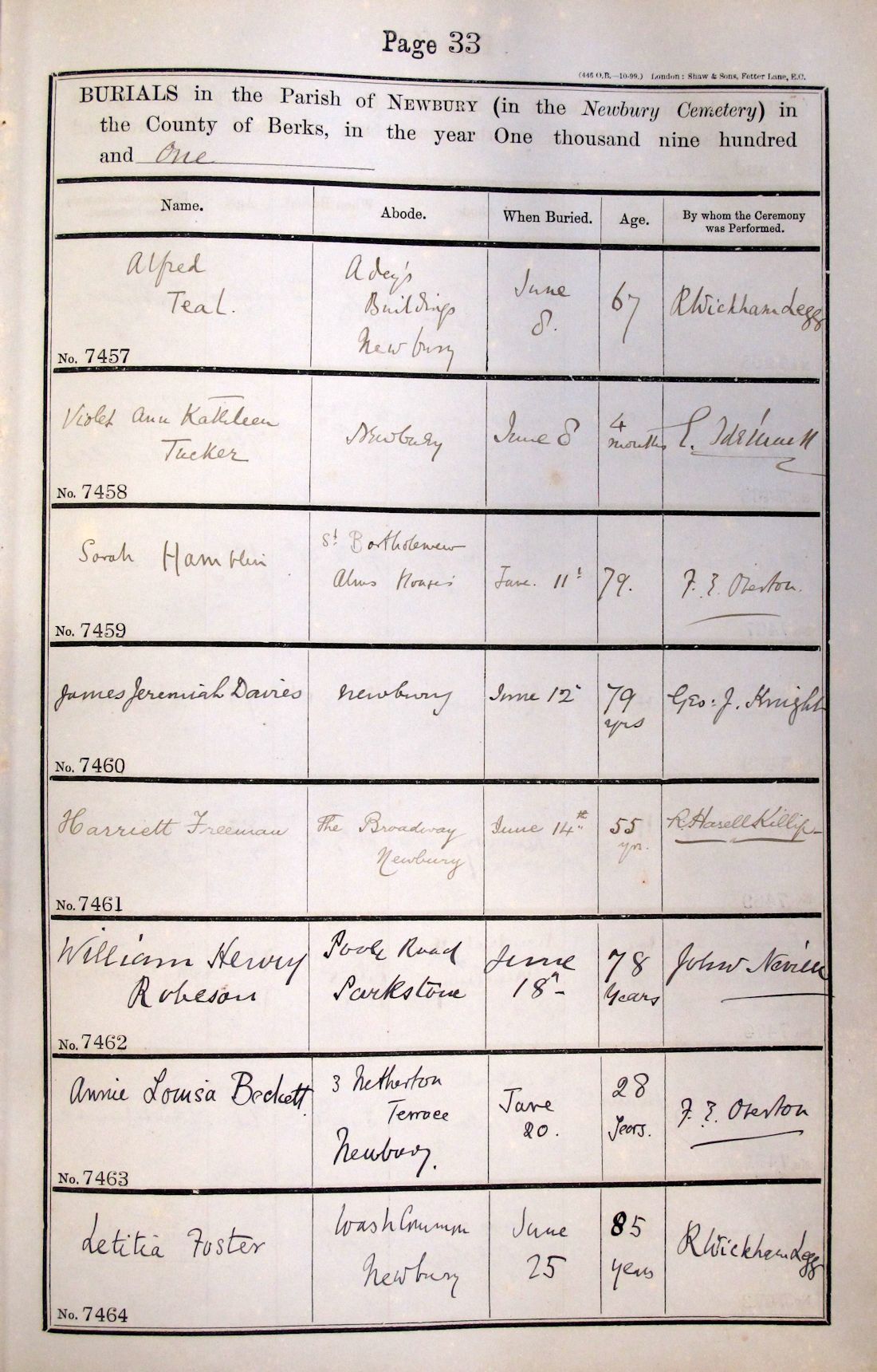
Burial Register entry for James Jeremiah Davies
©Newbury Town Council
Reproduced with kind permission
Memorial Details
| From top of headstone: In Loving memory of/ Mary Davies/ who died Feb.23rd. 1858/aged 27 yrs. Also James W. / son of the above/ who died march 17th. 1858 aged 8 years./ Also In Loving Memory of/ James J. Davies/ who fell asleep June 7th. 1901/ in his 80th.year/ "Gentle unto all. Patient 5.2 Tim. 2, 24. Also Mary Hannah Davies/ born Dec. 1st 1830 died Nov.25th. 1923./ "A lover of hospitality." | |
| Name on Memorial | James J. Davies |
| Date of death | 07/06/1901 |
| Age | 30 |
| Gender | Male |
| Memorial Type | Headstone |
| Construction Material | Sandstone |
| Condition of memorial | Engraved; poor |
| Pattison Location Code | LS(H)42 |
| Others named on memorial | |
| Mary Davies | |
| James W. Davies | |
| Mary Hannah Davies |
Memorial Images
The pictures below show the memorial on which James Jeremiah Davies is named.
Click an image to show an enlarged version of it.
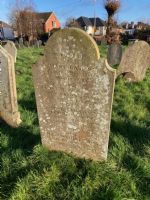
Newspaper Cuttings
The articles below have been transcribed from newspapers and magezines.
James Jeremiah Davies
| Source: | Newbury Weekly News |
| Article date: | 13/06/1901 |
| Copyright: | Newbury Weekly News |
| Transciption: | JAMES JEREMIAH DAVIES THE LATE MR. J.J. DAVIES Another of our old and esteemed townsmen has passed away in the person of Mr. James Jeremiah Davies. Coming from Reading in the year 1847, he first occupied the shop where Mr. Charles Edmonds, the grocer, afterwards carried on business. In 1852, he removed to the shop on the opposite side of the street which was formerly the residence of the well known solicitor, Mr. Jeré Bunny. In Mr. Bunny's time the garden and grounds extended the length of West-street, but after his death the house was converted into business premises, and a thoroughfare being opened, West-street sprang up. The greater part of the present shop was built by Mr. Davies, and there he successfully established the earthenware and china business which enabled him to support a fairly large family, and which remains in the hands of some of his sons. From early years Mr. Davies was afflicted with a weakness of the spine, which increased as he grew older and gradually incapacitated him from all work of a public or arduous nature. But naturally of a very bright spirit, he derived much enjoyment from life, and possessed a busy energy which he turned to account in many ways. For some years his strength has been decreasing, and latterly he has failed rapidly. Still the end was sudden when it came. Only two days before his death he was sitting up, but on Thursday last collapse of the heart was feared, and on Friday evening he quietly passed away. Most of his family were with him in his closing hours. Though taking no active part in municipal affairs Mr. Davies was keenly interested therein; he was well versed in social and political history, and to the last kept in close touch with contemporary politics. Coming from good old Nonconformist stock he took great interest in the Baptist Church, in the Christian tenets of which his family for several generations had been reared. He was for many years superintendent of the Newbury Baptist Sunday School, when it met in the old chapel in Northcroft-lane, and also for some time after the new Baptist Chapel was built. In its erection he took the liveliest interest. He was a deacon of the Baptist Church under the successive ministries of Revs. F. Robertson, Geo. Howe, E. George and the present pastor. As missionary secretary he greatly aided that cause. For some years he was a local preacher and chairman of the village committee. Mr. Davies was always well known as a keen advocate of temperance reform, was an abstainer from an early life, and for years manifested an active interest in the Band of Hope movement. In musical pursuits he took a great delight. At one time he presided over a singing class of 150 members, and under the late Mr. James Godding took part in many concerts and other musical functions. He had a pleasant musical, bass voice, and was in the Baptist choir for a great number of years. His love for Handel's music was great, especially "The Messiah" oratorio. Even in his old age, his memory was good for old tunes, madrigals, and glees, and at family re-unions he was quite to the front in suggestions, and delighted to join in singing so far as his weakness would allow. Mr. Davies leaves behind him a widow and eight children to whom, though his death is a severe loss, the memory of his life is fragrant and precious, and the power of his example an inspiration. The deceased was born in October 1821, and accordingly in his 80th year. A correspondent who was well acquainted with the late Mr. Davies, writes— The deceased was in many respects a remarkable man. For fully one third of his life he suffered under physical disabilities which might have crushed the spirit of a less brave man. At times he must have endured considerable and prolonged pain, and only the frail and weak can form even an approximate idea of what such affliction really means. It may be described as a contest between mind and matter- a constant struggle in which the nobler part of man gloriously triumphed. Those who enjoyed the privilege of acquaintance with Mr. Davies will recall his cheerful, hopeful, uncomplaining disposition; his intelligent outlook on current events, the eagerness with which he discussed social, economic, political, and religious problems; his retentive memory, and the lucidity with which he re-called the history of the Victorian era, and the great changes he had been permitted to witness; his warm sympathy with any movement calculated to improve the lives of his fellow countrymen, and his condemnation of vices which he saw to be inimical to the best interests of the country, and especially to the happiness and prosperity of the rising race. For nearly 16 years he had been a regular correspondent to a West of England journal, and I am in the position to say his letters have created an interest and awakened a curiosity as to the identity of the writer beyond those of any other contributor. He had a faculty for introducing controversial topics with the clever skill of an angler, and numerous were the the occasions upon which the bait tendered by the deceased was swallowed with avidity. In politics Mr. Davies was an old-fashioned Liberal. A great admirer of Mr. Gladstone, he did not hesitate to support his Home Rule proposals for Ireland, but on Labour questions he was more Conservative than the younger school of Liberals, His distrust of Socialism led him to break many a lance with opponents of Socialist doctrines, and he did not view with unmixed approval some of the recent developments in Trade Union circles. Hence it followed that the deceased frequently found himself out of harmony with some of the readers of the newspaper to which he so long and regularly wrote, but on the other hand his caution and prudence commended themselves to many people, and it is no exaggeration to say that his removal will be regretted by scores who never saw him, nor even heard his name. He was a strong advocate of thrift, and by precept and example counselled abstinence from intoxicants and a general practice of economy. Although compelled to live the life of a semi-recluse, his mind was always on the alert to welcome the latest discoveries in science, and his friends were often surprised at the information which he acquired and the faculty with which he used it in conversation. Geology, astronomy, botany, each in its turn claimed his attention, and as a result his communications to the press frequently testified, not only to the extent of his reading, but his capacity for thinking along original lines. Unlike the "Little Gentleman" in Oliver Wendell Holmes book his bodily affliction raised no rebellious thoughts nor engendered bitter feelings. Not for him was it to say "My life is the dying pang of a worn-out race, and I shall go down alone into the dust, out of this world of men and women, without ever knowing the fellowship of the one or the love of the other." Happily, the long period of his exclusion from these scenes of activity with which his earlier years were associated, was brightened by many social and religious enjoyments, and it is in this connection mention may be made of Mr. Davies' love of music, the keenness with which he would play a game of chess, the delight he experienced in retailing a good story or joke, the interest he took in the movements of his children, and the scholastic successes of his grandchildren. Until middle life he sang at public concerts, and old residents in Newbury will recall how on the occasion of Mr. C.H. Spurgeon's visit to the town, when the popular divine preached in the Corn Exchange, the important duty of starting the hymn tunes was entrusted to Mr. Davies. It may be left to others to refer to his business career, marked as it was by early struggles and indomitable perseverance. I have endeavoured to speak of his qualities of heart and mind, and how ever imperfectly I may have performed the mournful task it will be conceded that the life just ended was not without a measure of inspiration for minds capable of understanding that quiet, unobtrusive heroism which irradiates and sanctifies the home and which before the open grave leads us "To prize the breath we share with human kind, And look upon the dust of man with awe." THE FUNERAL The funeral took place on Wednesday. The first part of the service was in the Baptist Church, Northbrook-street. The body was conveyed from Ashley House, London-road in a Washington car followed by several mourning carriages. The service was conducted by the Rev. George J. Knight, the pastor of the church, who said although he purposed dealing more particularly with the life and example of Mr. Davies at a special memorial service, next Sunday evening, yet on the present occasion he felt he ought express the sympathy of the whole church with the mourners. Mr. Davies had for 50 years or more been amongst them, and they realised what a truly Christian life he had led. He (Mr. Knight) regarded him as one of the most remarkable men of Newbury. His physical trials were great, but his believing spirit and quiet reliance on an unseen Power carried him throughout a lengthened and trying life. And now he had gone to be with the Lord, and to enjoy a life of which the human mind could not imagine the joys. To know him was to esteem him for his beautiful spirit, and his hopeful quiet life. Touching on his church work, Mr. Davies had been a follower of the Christ for over 60 years and for thirty years had been a deacon of the church, until of recent years the annual church meeting had elected him an honorary deacon for the remainder of his life. His was a life they all might emulate, to make a friend of Jesus, so that at the end, like their departed brother, they might say death had lost its sting. He had gone, and it was with certain hope that they rejoiced he was departed to be with Jesus. Wesley's hymn "Come let us join our friends above" was then sung, and after a short prayer the body was conveyed from the church to the cemetery. The coffin was of polished oak, with brass furniture, and bore the inscription: JAMES J. DAVIES Died June 7, 1901 Aged 79 The mourners were Mrs. J.J. Davies (widow), Mrs Thompson (daughter), Messrs Philip E. Davies, Macfarlane Davies, James W. Davies, William H. Davies, and Walter J. Davies (sons), Mr. W. Thompson (son-in-law), Mesdames P.E. Davies, Mac F. Davies, J.W. Davies, W. H. Davies, W.J. Davies (daughters-in-law), Mrs. Cooke (sister-in-law), Mrs French (aunt), Messrs. E.P. Collier, J.P. and T.S. Waite (nephews), Messrs. A. Jackson, J.P., T.M. Nias, W. Miller, G. Bowden, J. Rowles, and L. Clayton (deacons of Newbury Baptist Church), Messrs. W. Cordrey and W. Wood (deacons of Bromley-road Tabernacle, Lee S.E.) There were also present in the Chapel, or at the graveside, Mr. and Mrs. Mortimer, Messrs. A. Whitington, J. Siney, F.C.Hopson W.E. Lewendon, S. North, S. North jun. J. Grimwood, J. Lane, F. Bentley, R. Eatwell, Steptoe, sen. And jun., Mrs. Nias, Mrs. Chivers, Mrs Mortimer, Miss Dyer, Miss Bentley, Mrs. Newton, Miss Allen, Miss Walker, Mrs. Longford etc. The coffin was covered by a number of beautiful wreaths, among which were:- A tribute of affection from sons and daughters; in loving memory of dear Grandpa from Nell, Mary and Arthur. In loving memory of dear Grandpa, from Maggie, Charlie and Edgar. To dear grandpa from Mildred, Norah and Donald. With loving sympathy in remembrance of dear grandpa from Mac and Bert. In loving memory from Tom, Kate and Mary. With deep sympathy from Mrs. Cooke and Mrs. Dyer. In affectionate remembrance, from Mr. and Mrs. Mortimer and family. A tribute of esteem from the deacons of the Baptist Church, Newbury. With the sincere respect and sympathy of the firm's employees. With sympathy, tender and true, from J.H. and T. Thompson. With Mr. and Mrs. W.H. Cordery's sincere sympathy. With much sympathy and loving remembrance of an old friend M.A. Vince. Newbury Weekly News 13 June 1901 |
| This obituary entry is awaiting verification. |
Pictures and photographs
The pictures below are all linked with James Jeremiah Davies.
Click an image to show an enlarged version of it.

Davies shop on right with the Camp store on left. Sadly now replaced by Metro bank formerly Halfords
©
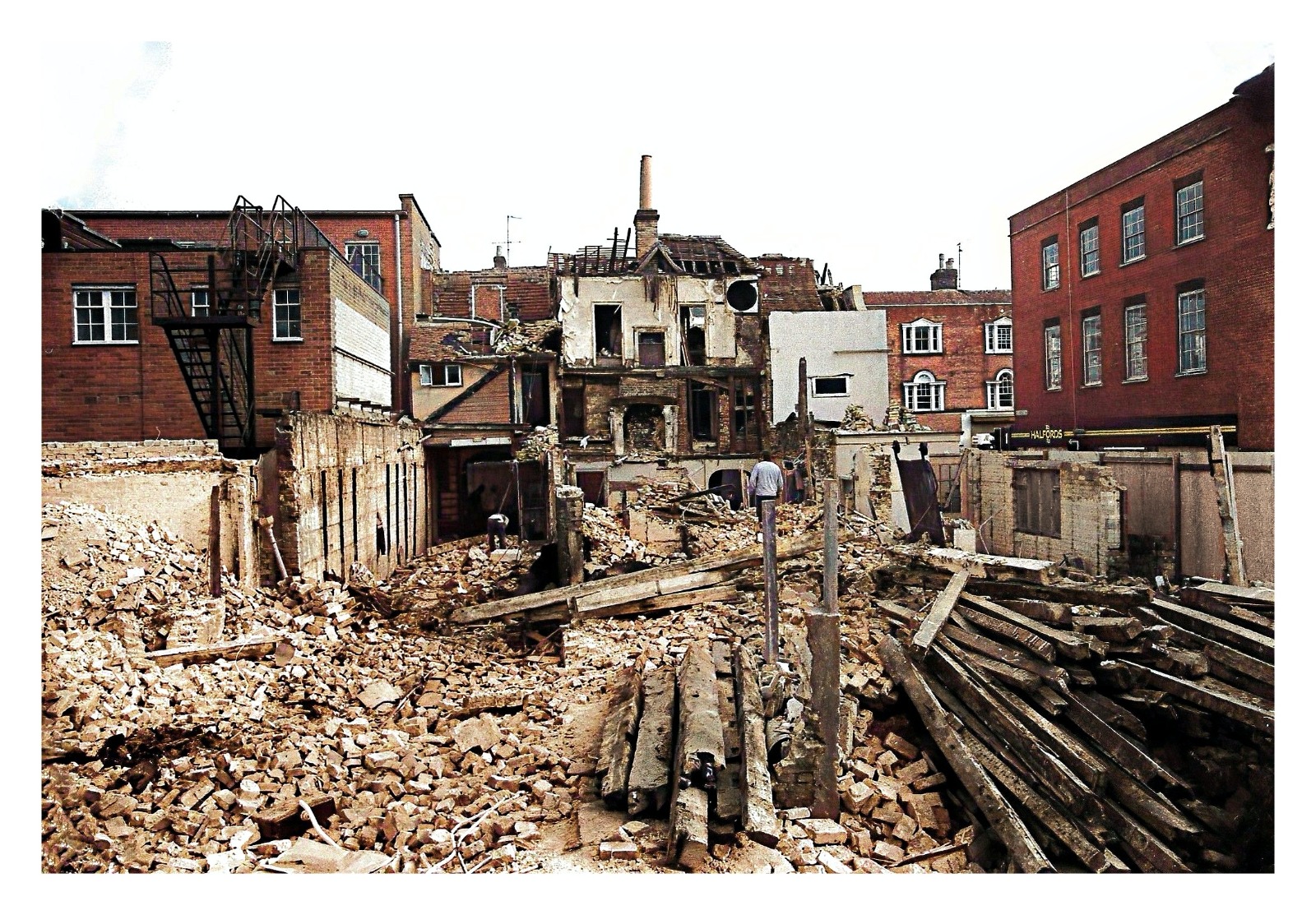
Davies shop being demolised to make way for McDonalds !!!??
©
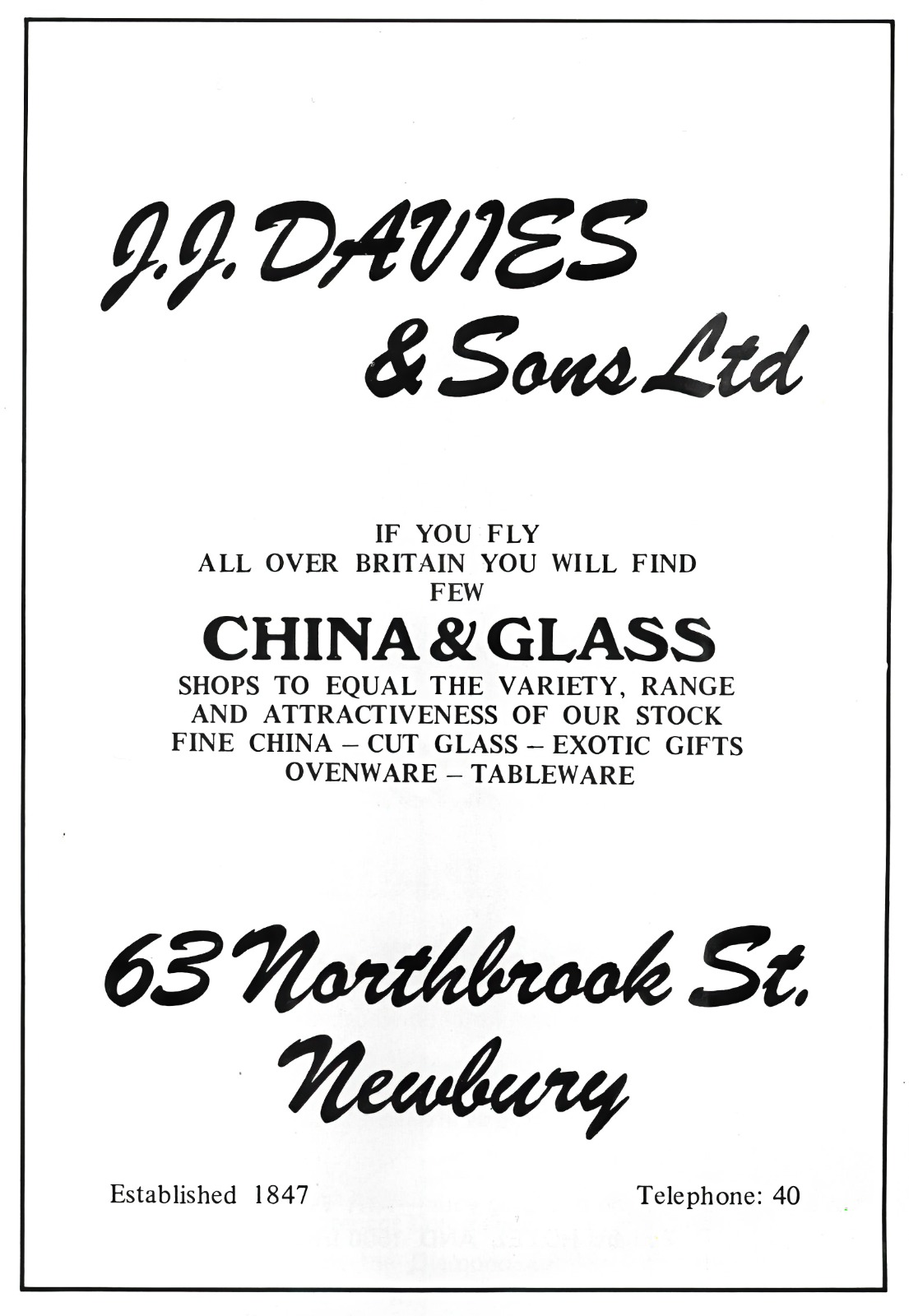
J J Davies advertising
©
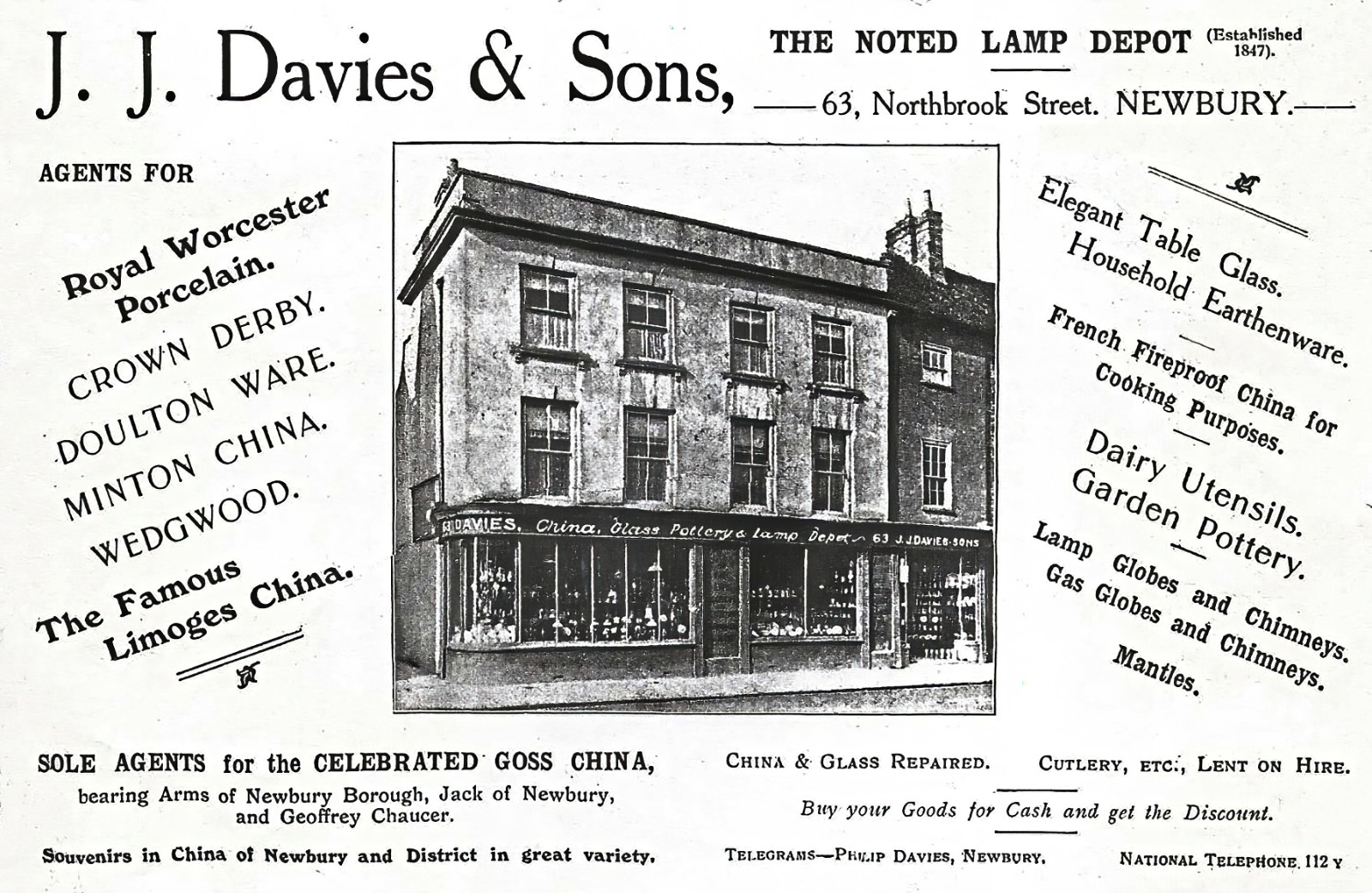
J J Davies advertising
©
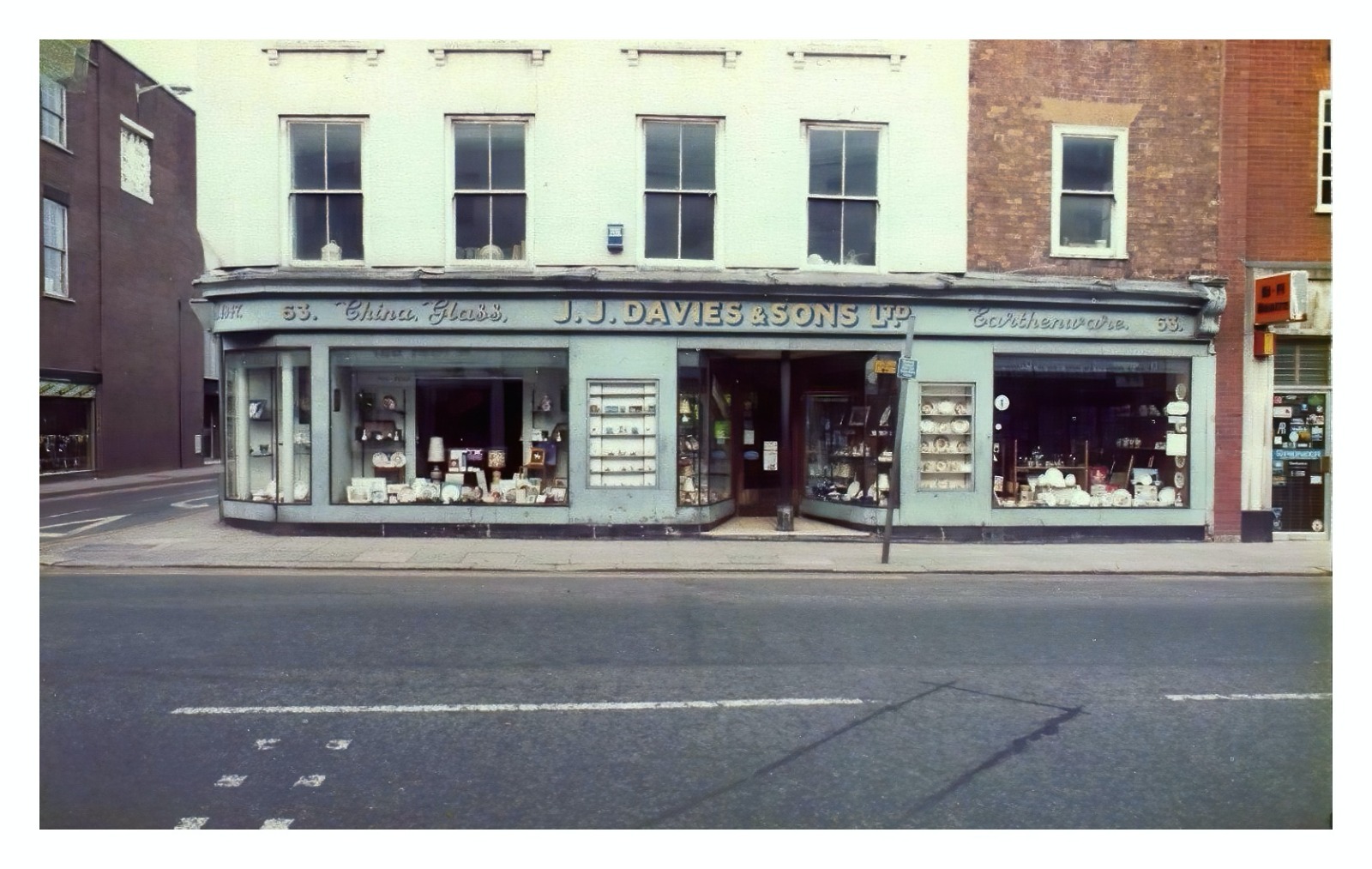
J J Davies shop front
©
.jpg)
J J Davies shop front with view of the newly built Halfords
©
.jpg)
interior with vine
© jim bradshaw
.jpg)
Northbrook street
©
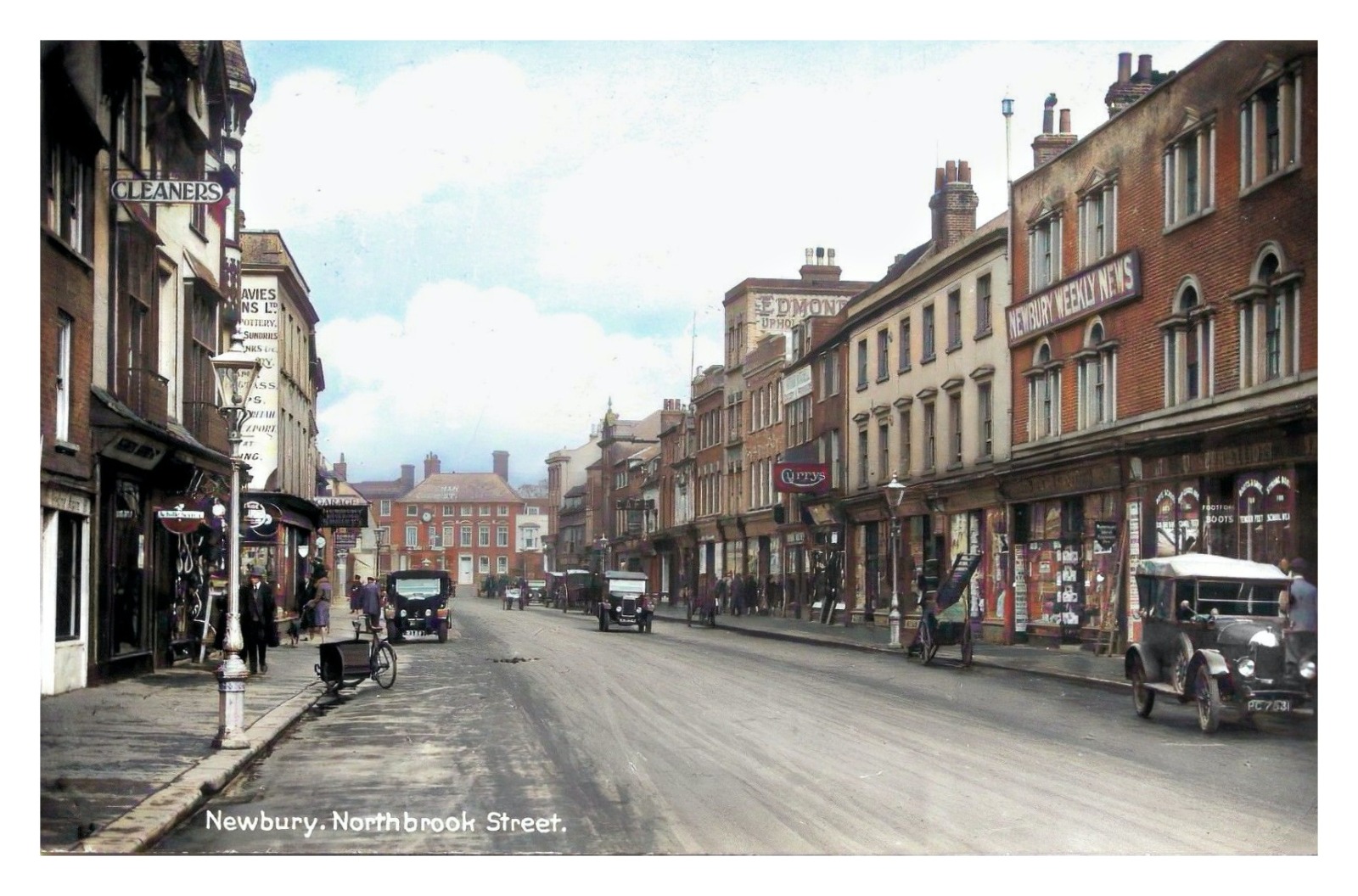
Northbrook street
©
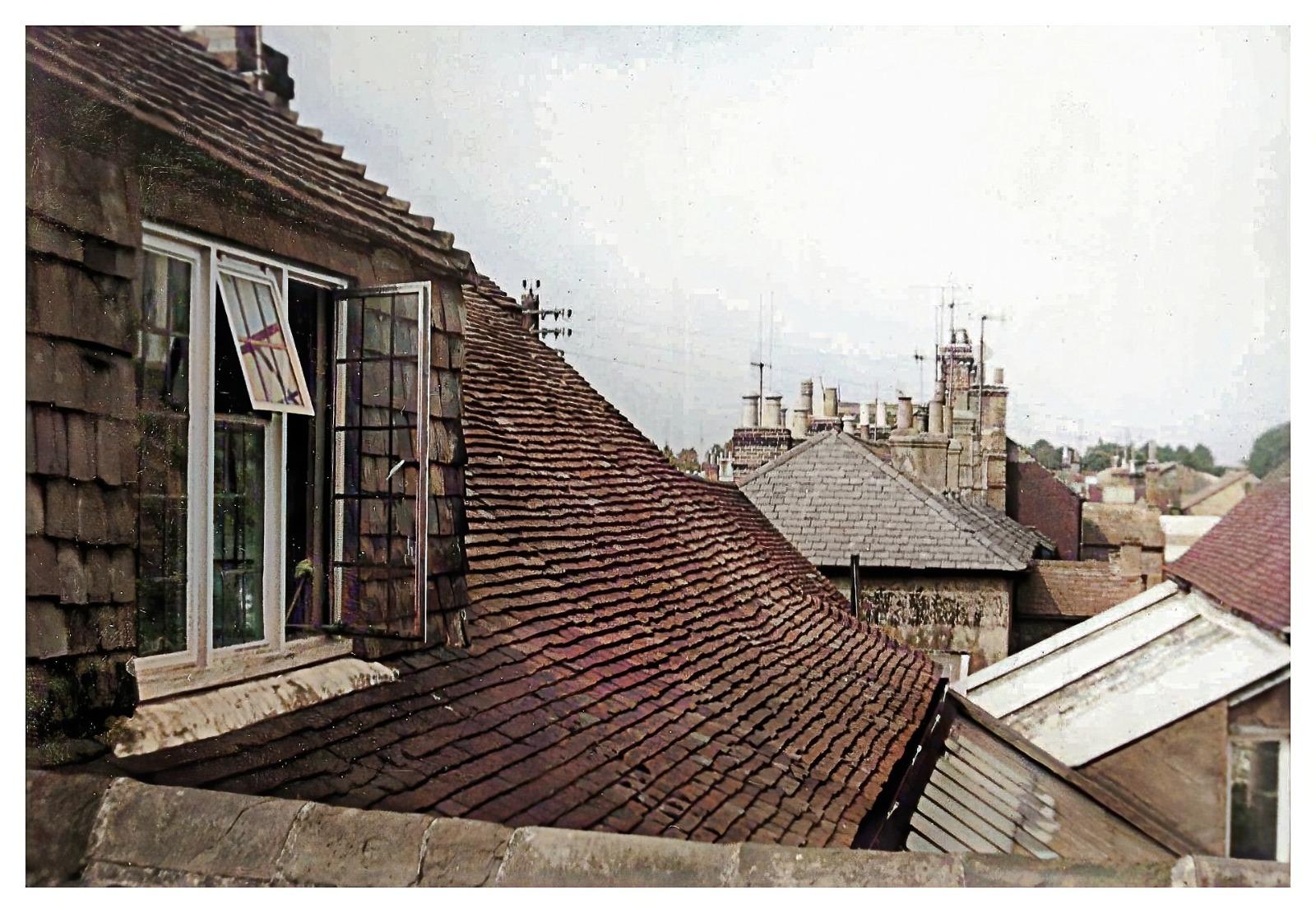
Northbrook street
©
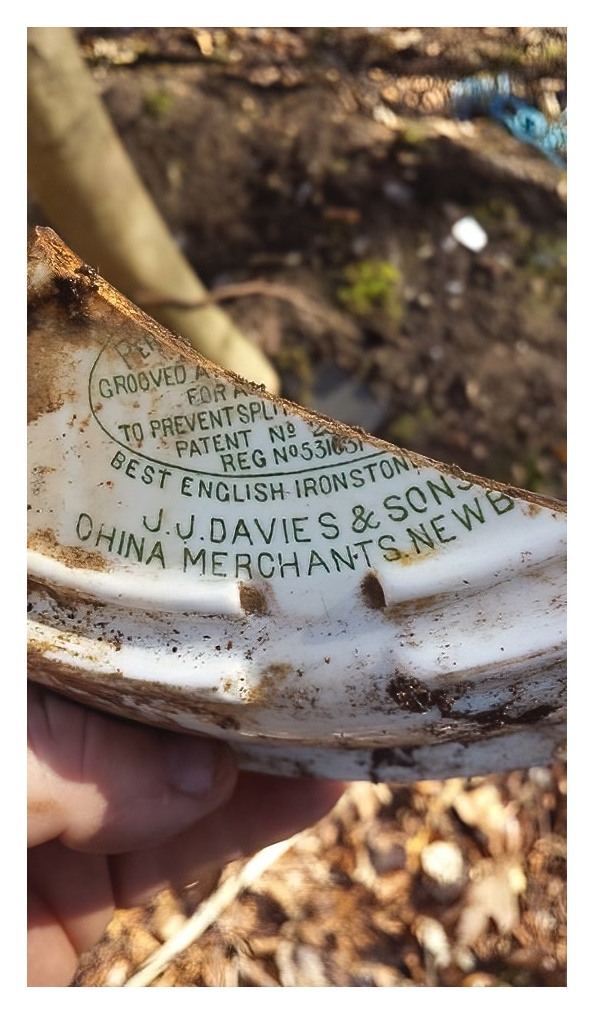
broken plate
©
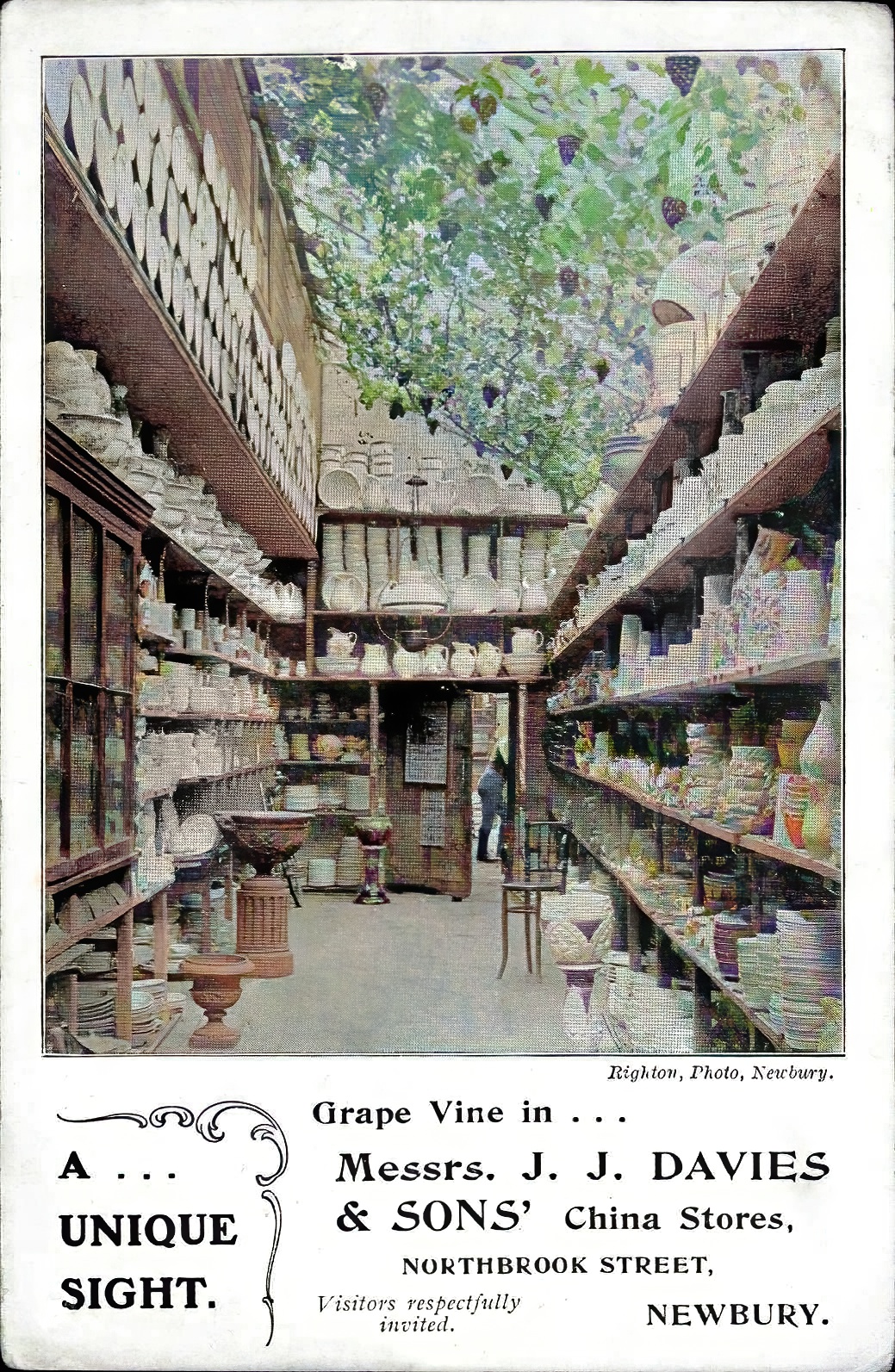
store with vine
©
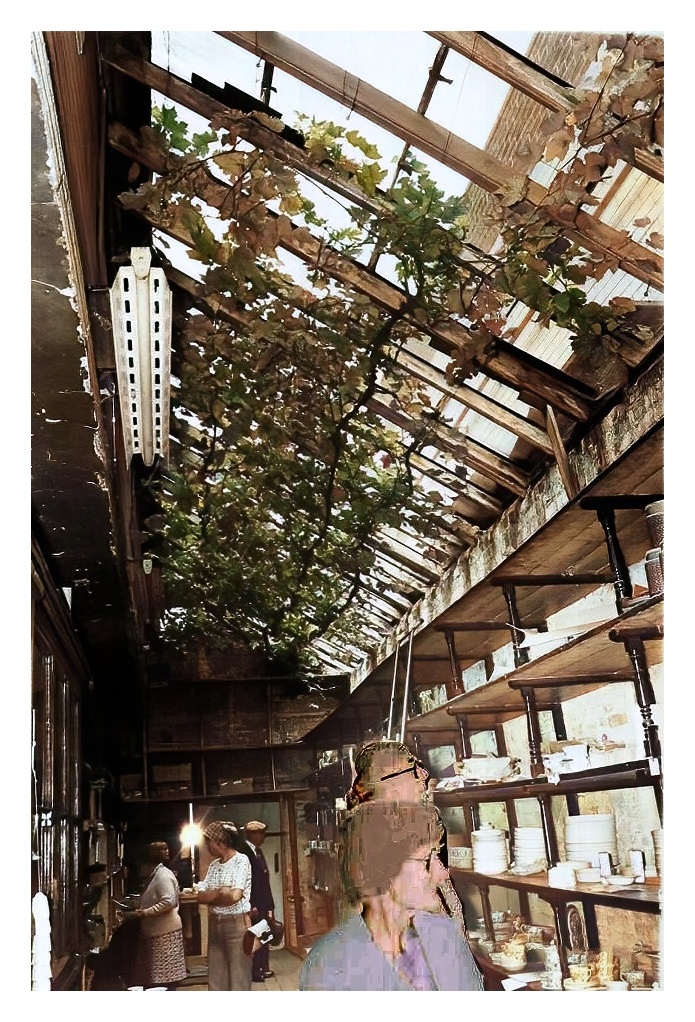
store with vine 2
©
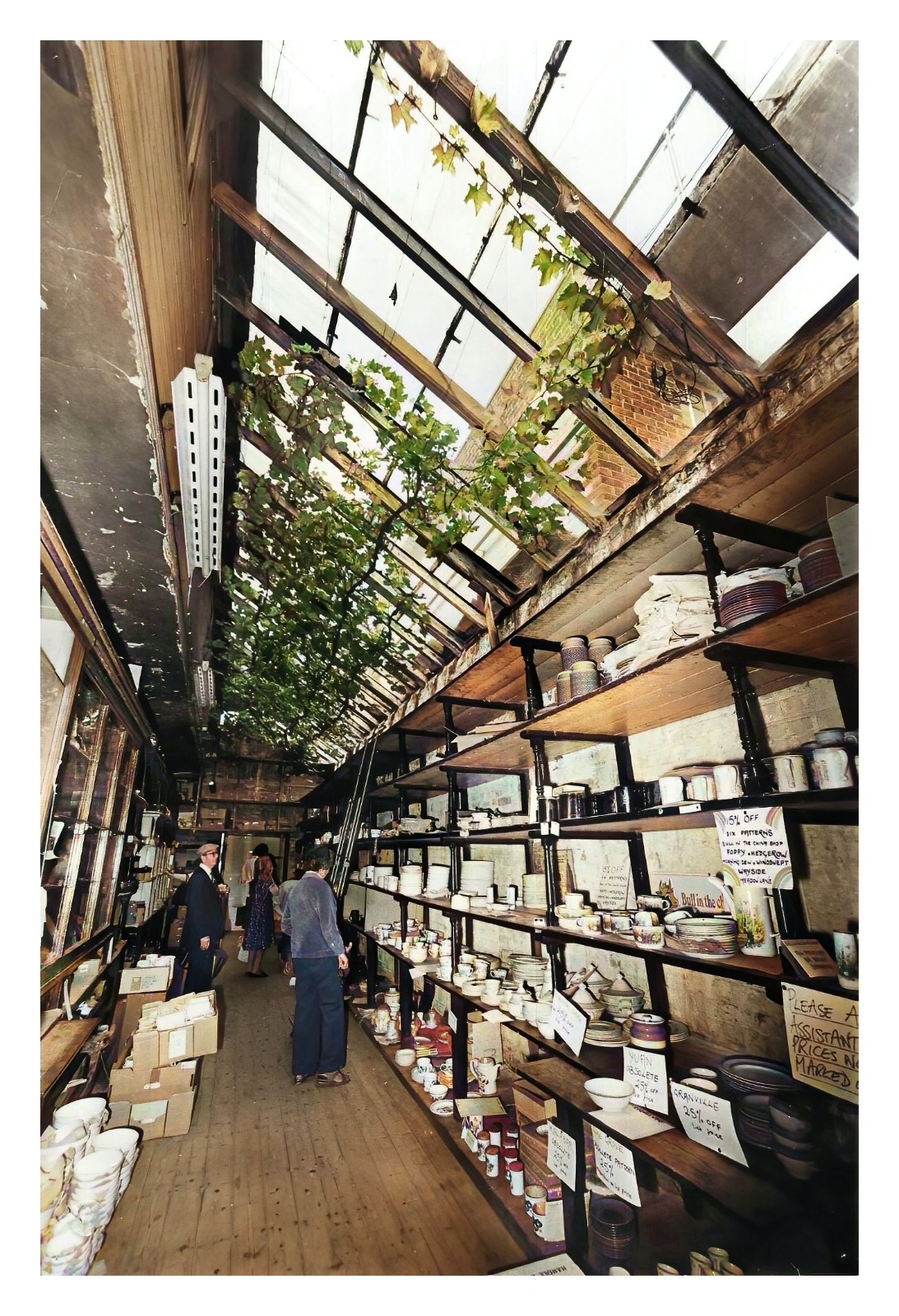
store with vine 3
©
.jpg)
vine
©
.jpg)
interior with vine
© jim bradshaw
Biographical Information
The articles below contain information about James Jeremiah Davies.
notes on 63 Northbrook Street, Newbury
Some notes on 63 Northbrook Street, Newbury
(Reprinted from “The Transactions of Newbury District Field Club” – 1970)
By Peter J. M. Davies, m.a.
I have assumed that I was asked to write this article for two or three reasons: to record the history so far as it is known or can be conjectured of my family business premises, 63, Northbrook Street, to show from it how many similar buildings, and therefore Newbury itself, must have developed and to include in it any reminiscences which give a picture of the town as it was before modern life made it like any other town. Past numbers of the Transactions have numerous notes and small articles about features of interest or buildings which were disappearing in Newbury so I add this article to them in the belief that such jottings may be of interest and value to the many people who know Newbury only as it is now.
Above its mainly unedifying shop fronts Northbrook Street has a venerable enough appearance but it is in fact the newest part of the old centre of Newbury. The town must first have grown from a settlement guarding a crossing of the River Kennet, probably on the south bank since the parish church of St. Nicolas is there and the City, further to the south, is always looked upon as the oldest part of the town. The City, between the Litten and the Hospital, contains a quantity of old almshouses and the old Manor House as well as Fair Close where the old St. Bartholomew's Fair was held. St. Bartholomew's Grammar School was also originally here.
Between the City and the Kennet runs Bartholomew Street, which, with Cheap Street and the Market Place, must have been reasonably well settled by early Medieval times. The Wharf behind the market place was the site of Newbury Castle, demolished during or after the time of King Stephen. The one remaining building in the car park is said to be built from stones taken from the castle and was erected when the Wharf itself was laid out at the time of the construction of the Kennet and Avon Canal at the end of the 18th Century.
Similarly at the other end of the town, from the Broadway northwards, is the settlement of Speenhamland adjacent to the Roman settlement of Speen. This was not then part of Newbury but was separated from it by a causeway. The Marsh is the name still used by old inhabitants for the area now prosaically called Victoria Park.
Obviously communication between Speenhamland and Newbury (named Ulvritone at the time of the Conquest) would have been inevitable and the resulting track across the marsh
eventually became Northbrook Street. The pattern of its development can be imagined from a glance at still existing village streets in the district, from a street of scattered buildings, gardens and fields as at East Garston to a continuous street with its gardens backing on to fields as at Aldermaston. Newbury as a centre of a great farming and sheep raising area became important as a cloth manufacturing town and its greatest days were in the 16th Century when Jack of Newbury had his cloth factory in Northbrook Street on the site now occupied by Marks and Spencer and in the building still standing next to that shop. Until the early 19th Century the cloth trade prospered, supplemented by the normal activities of a market town and towards the end of this period the increasing population encouraged the development of those many courts at right angles to the main streets consisting of cottages now condemned or destroyed.
63, Northbrook Street reflects in its own history the development which took place from the 16th Century onwards. During recent repairs to a wall we uncovered some of the original timber and wattle and daub which Dr. Kaines-Thomas dates to the middle of the 17th Century when the house was built. At that time it would have presented to the street a typical "Tudor" or Jacobean timbered front surmounted by six dormer windows, the only solid masonry being the central fireplaces and chimney breast. Inside the building some of this timbering is still visible, but the chimney breast on the ground floor is concealed behind showcases, only appearing on the second floor. On its south side the building butted on to the space or building now occupied by Halfords. On the north was probably a field or garden extending to the Monument Inn, with a carriage drive next to the house leading down to the stables. In front ran the North Brook.
This brook which gives its name to the Street and saves us from the banality of a High Street runs from Northcroft Lane to the Broadway, its direction of flow explaining why true inhabitants of Newbury refer to the Water Bridge as " up" the street and the Broadway as " down." The brook now runs in a culvert but my father remembers a watercolour in the house in his childhood which shewed the brook as being crossed by numerous small bridges and planks. A picture of the same subject hangs in the Municipal Buildings. During alterations eight years ago we found under the shop floor a culvert with a beautifully arched top in brick which appeared to run from our stables into the North Brook. No doubt in what the Victorians would have called "those unenlightened times" the brook served as drain and supplementary water supply.
The 18th Century saw many changes in Newbury. The Pelican, the Chequers and the other inns in the Broadway were an important stage on the coach road from London to Bath and the West, so new houses were built and old ones were refaced to be in keeping with the times. Our building was one of the latter and a Georgian stucco front was applied to it with a parapet to disguise the dormer windows and conceal the sloping roof. Rooms were built over the entrance to the carriage way and alterations were made inside. The original staircase was replaced by one with a plain carved handrail and turned banisters and at least one room was panelled. This attractive room still exists intact and is almost identical in style with rooms which I occupied at Cambridge in a building designed by Gibbs in 1739. Exactly when these alterations were made is not known but by the middle of the Century another more drastic alteration was also made. West Street was developed and the southern end of the house was demolished to make room for it. This we discovered during the alterations eight years ago when it was found that the roof timbers on the outside of the West Street wall had been chopped off and the wall itself, of very poor workmanship, built up in the cheapest and quickest way possible. A map dated 1775 in the Borough Archives, the earliest I have seen, shows West Street extending about as far as the new Inland Revenue building, bordered by fields but with few houses and continued across a field by an avenue of trees.
It is clear that before West Street was formed all the land between what are now West Street and Albert Road and extending back to Elliott's works on Northcroft belonged to this house. The deeds of the property do not go back before 1854, but until the 1930s we were expected to collect the tithes from all the houses in those two streets. By the 1930s my father found it more convenient to commute all the tithes for a lump sum to extinguish this liability.
In 1847 my great grandfather, James Jeremiah Davies, came from Reading to found our business. I have a copy of the Reading Mercury dated Saturday Morning, October 23rd, 1847, containing a flowery advertisement to the effect that J.J.D. was offering a range of China, Glass, Bohemian Crystal, Alabaster, Window Glass, Lamps and many other items which we still sell. This was at 41, Northbrook Street where the Southern Electricity Board now is. Two or three years later he moved to the present premises which he bought from a lawyer with the unusual name of Jere Bunney. For the first time the house was no longer wholly a private residence. The downstairs rooms were fitted with showcases and the carriage drive covered with a glass roof. These original fittings survive and can now be considered to have period charm. The glass roof, as it faces north, gives a bright light so my great grandfather planted the Black Hamburgh grape vine which still flourishes there, is well over a hundred years old, comparing favourably in age with the Hampton Court vine, and must be the only grape vine in a shop in this country. The weather boarded side of this building still overhangs the covered drive as it did when it was outside, and in my father's young days there was still a pump there. Beyond this the old kitchens, outbuildings and stables were gradually transformed into warehouses and glass cutting rooms though the old harness room still has remnants of the rush matting which kept the leather from the damp walls and some of the non-slip stable flooring is still in place. In fact the stables were still used as such until the 1914 war when the Army Remounts commandeered the last horse from the shafts of its cart in the Market Place.
The horse was not the only means of transport. At one time my great grandfather lived in the London Road in a house whose garden ran down to the Canal. By the bank was mouldering a barge which he used to send up to the Potteries for goods which were unloaded at the Wharf, which at that time had a number of basins at right angles to the canal. From his time few alterations were made to the building until in 1961/62 we extended to the first floor, opening the panelled rooms as show rooms and revealing the only surviving part of the Georgian staircase. It only remains now for me to add one or two anecdotes which give a picture of what Newbury was like during the 19th Century as I have had it told me by my parents.
First I must mention the Bunney family from whom we bought the house. When I was a boy there were still two Misses Bunney living in Donnington Square which at that time seemed to me to be a refuge for spinsters or maiden aunts, but we never heard what happened to the original Jere Bunney. However, in 1926 my father was in New Zealand, and walking along the quay at Wellington saw a lawyer's office named Jere Bunney. No one could give him any information as Mr. Bunney was on a fishing trip of indefinite length, and when I walked the same way in 1951 Mr. Bunney had just died. We imagined that there must be some connection and two years ago a visitor from Australia asked if I knew anything of a family named Bunney who lived at Murradup in Western Australia and thought they originated from Newbury. Apparently they went to Murradup from New Zealand and bought a sheep station.
Soon afterwards the father died and his eldest son, aged about 12, took over and made a success of it.
I have heard many stories of restless sons of local families who went out to remote places in the last Century and did strange things. One is said to have married the daughter of the king of a cannibal island and succeeded his father-in-law in due course. Another appeared home from a South American cattle boat with no shoes, but with an enormous cattle whip. Later as a police officer he had control of an area of Rhodesia as big as England. One helped to build the mosquito infested Panama Canal and complained that it was too civilised. Others went to Klondike and came back with their pockets full of bags of gold dust. At least one of these hired Cary's Hall for dances for his friends until his gold had gone and he had to be off again.
Newbury was a quiet and peaceful place in those days and these incursions must have created some stir, but there were other colourful visitors. A Russian with a dancing bear appeared in the streets most winters at the end of the century as did a very good German or Viennese band in Hussar costume. The opportunity was once taken to hire them for a dance in the Corn Exchange. My parents also remember Mr. Wilson, the vet., who lived in a yard off the Broadway with a complete horse's skeleton above his surgery door, who used to drive on his rounds in the snow in a horse-drawn sleigh with bells. The Broadway in fact had quite a rural atmosphere. A baker, whose chicken spent their days pecking corn round the horse trough in the middle of the road, had his bavins of wood for the oven delivered onto the pavement outside his shop. They occupied most of the pavement and stayed there until he had the time and inclination to move them. Throughout the town there were shops specializing in every conceivable article; a bookbinder, a taxidermist, a silk shop with nothing but bales of silk. One wonders how some of them made a living: an old man with sides of bacon hanging up but only a few windfall pears in the window, a dark shop down steps with nothing but a basket of eggs in the window, a woman who sold " hundreds and thousands " in her front room and a shop where locust beans were sold from a sack by the handful, the amount depending on the size of the hand.
Quiet our ancestors' lives may have been but they were energetic, and we owe a great deal to them in the wealth of our present day activities. This town has a remarkably large number
of organisations catering for almost every interest. The Newbury District Field Club itself has been in existence since 1870, many other cultural and sporting societies can trace their roots back to the last century as can, for instance, the Newbury Symphony Orchestra in which three generations of my own family have been playing for 90 years.
With the growth of Newbury from a quiet market town with its own character, from a closed community to the present typically 20th Century conglomeration it is obvious that few of its present inhabitants know much of the town's past. I hope that this article has given them a glimpse of that past and may encourage them to try and find out more.
Author: Peter J M Davies
© NDFC
*The FNRC believe that the certificates published on this page have been added in compliance with the rules laid down by the General Register Office (GRO). Click here for more information.
If you believe that we may have inadvertently breached the privacy of a living person by publishing any document, please contact us so we can immediately remove the certificate and investigate further.
Thank you.
FNRC.
© 2010-2023. Friends of Newtown Road Cemetery, unless otherwise stated.
Web site designed by Paul Thompson
The Friends of Newtown Road Cemetery is a not-for-profit organisation that works in association with Newbury Town Council to look after and maintain Newtown Road Cemetery for the benefit of the people of Newbury.
